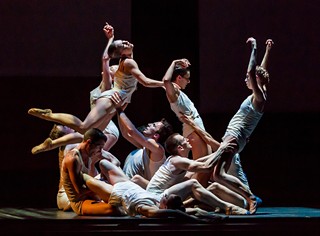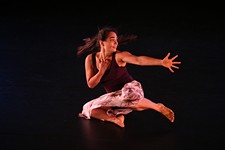Dancing What's Overwhelming
Two choreographers tackled weighty topics onstage last week in a remarkable fashion
By Robert Faires, Fri., March 30, 2012
Same venue, same weekend, two different works of contemporary movement prompting the same question: How do you make a dance out of that?
Upstairs in the Long Center, it was the Holocaust causing the perplexity; downstairs, cancer. Though both of those immense – and immensely devastating – topics have been tackled in countless literary works and we face no shortage of dramas about them on either screen or stage (case in point: Wit, currently in revival at City Theatre – see "Wit," March 23), something about dance strikes us as ill-suited to addressing the enormity of loss at the heart of those subjects. Maybe it's the delicacy that we associate with the movement, especially in ballet. Never mind that the form demands an athletic prowess and a strength that would shame many an Olympian. In our minds, we still tend to reduce dance to its daintiest moves: standing en pointe, skipping, twirling – which we assume can't possibly support matters of gravity. Or perhaps we don't trust the absence of words, imagining motion and gesture alone to be inadequate for conveying the magnitude of suffering attached to genocide or terminal disease.
Well, I don't know what quirk of scheduling put Sharon Marroquín's The Materiality of Impermanence in the Rollins Studio Theatre on the exact Friday, Saturday, and Sunday that Ballet Austin was remounting Light/The Holocaust & Humanity Project in Dell Hall, but it provided a potent double shot of proof that dance is capable of exploring momentous issues with a depth and power that may even transcend that of language-driven arts. In both, we saw images of traumatic isolation; of dancers undressing, their exposed flesh heightening their vulnerability before a ruthless aggressor, be it army or illness; and of healing in a comforting embrace. In tackling two very different subjects, the dances shared one road: the path of the personal. They focused on the individual response to the sweeping historical tragedy, the life-threatening malady – the impact that could be seen in a terrified pair of eyes; a stiff, outstretched arm; a faltering step; or a body gone limp. Approached on such intimate terms, overwhelming topics such as cancer and the Holocaust can be described quite eloquently and poignantly through dance.
Of course, Stephen Mills had already proven this with Light seven years ago. In the work's premiere, the BA artistic director transported audiences to the Nazi death camps without ever showing a soldier, swastika, or showerhead. The dancers thrown off-balance by an unseen force, the crush of nearly naked bodies in a rectangle of light, their seizures of dread, their frenzied tugs-of-war followed by a body dropping to the floor and rolling slowly into the dark at the back of the stage all did that for us. And they did again in Ballet Austin's first revival of the work, but with even more surety and focus. No longer fueled by the peculiarly intense energy of creation (or the pressure of trying to get everything finished by opening), Light drew power from the certainty of the work's message and the way it would connect with audiences. Mills and his dancers – most of whom were not with the company when Light was first produced – delved into a work that was set, exploring it with confidence and forcefulness. Now, Light is clearly not an ambitious roll of the dice that landed luckily on the first throw but the mature work of a choreographer who invested all of himself – his larger beliefs as well as his talent and skills – in its creation, with the intent that it would endure. It does and feels as much like Mills' masterpiece as any choreographic work of his I've seen.
How great then that Ballet Austin will take Light to Israel in September 2013 for the Acco Festival of Alternative Israeli Theatre and that other ballet companies came to see the remount and are interested in staging it. It deserves to be seen more, as does Materiality (see Exhibitionism, March 30, for a review). Like Mills, Marroquín has made the most profound personal investment in this work, and it shows. Here's hoping that the three sold-out performances for its premiere ensure a second life for her work, too.
Having two such deeply felt, powerful works about big, tough subjects so close together last week was a remarkable coincidence, and I get why people asked what they did about the dances. But with choreographers who possess the kind of commitment and compassion that Mills and Marroquín do, isn't the real question: How could you not make a dance out of that?












